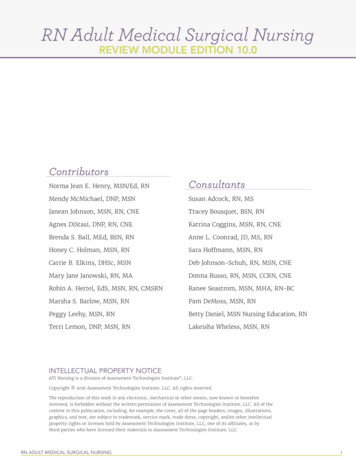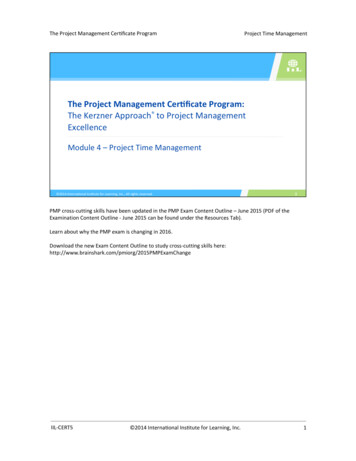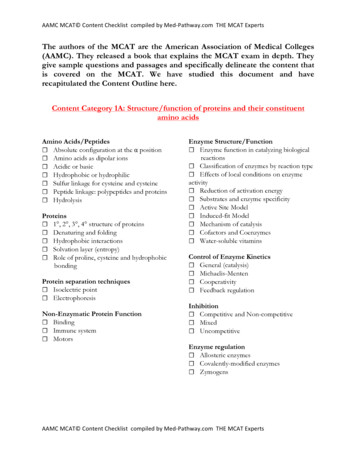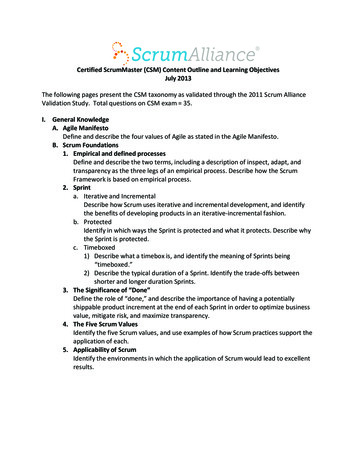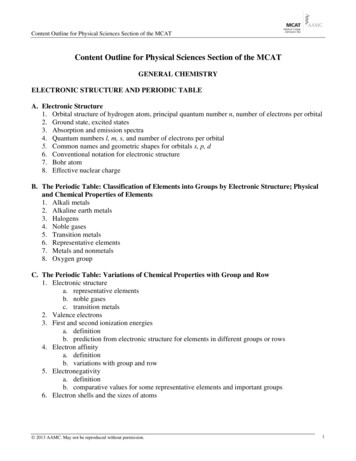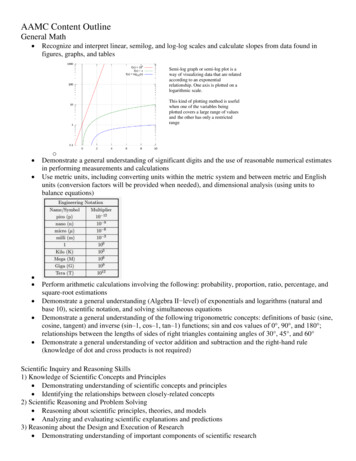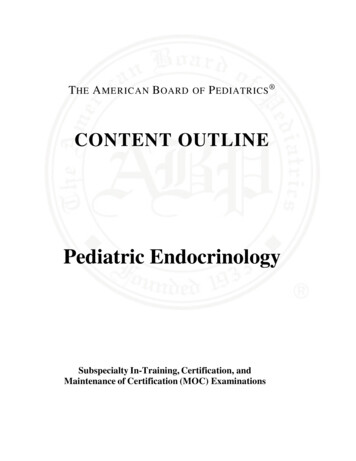
Transcription
T HE A MERICAN B OARDOFP EDIATRICS CONTENT OUTLINEPediatric EndocrinologySubspecialty In-Training, Certification, andMaintenance of Certification (MOC) Examinations
INTRODUCTIONThis document was prepared by the American Board of Pediatrics Subboard of PediatricEndocrinology for the purpose of developing in-training, certification, and maintenance ofcertification examinations. The outline defines the body of knowledge from which the Subboardsamples to prepare its examinations. The content specification statements located under eachcategory of the outline are used by item writers to develop questions for the examinations; theybroadly address the specific elements of knowledge within each section of the outline.
Pediatric EndocrinologyEach Pediatric Endocrinology exam is built to the same specifications, also known as theblueprint. This blueprint is used to ensure that, for the initial certification and in-training exams,each exam measures the same depth and breadth of content knowledge. Similarly, the blueprintensures that the same is true for each Maintenance of Certification exam form. The table belowshows the percentage of questions from each of the content domains that will appear on anexam. Please note that the percentages are approximate; actual content may vary.Content CategoriesInitialCertification bohydrate Metabolism16%16%2.Bone and Mineral Metabolism8%8%3.Thyroid Hormones (Thyroxine[T4] and Triiodothyronine [T3])13%14%4.Adrenal wth12%14%7.Reproductive Endocrine System12%12%8.Other Hormones3%3%9.Lipoproteins and Lipids3%3%10.Multiple endocrine neoplasia andpolyglandular autoimmune disease2%2%11.Methods and Biological Principles4%2%12.Core Knowledge in Scholarly Activities5%4%
Endocrinology1. Carbohydrate MetabolismA. Integrated hormone effects on metabolism1. Physiologya. Know the sources of glucose from: digestion and absorption of dietarycarbohydrates; endogenous release of glucose from the liverb. Know the enzyme systems (glycogenolysis, glycogen synthesis, glycolysis,gluconeogenesis, tricarboxylic acid cycle, and pentose phosphate shunt) involvedin the storage, oxidation, and production of glucosec. Understand the processes and regulation of nutrient and substrate metabolism inthe fasted and fed states with regard to glycogen, glucose, fatty acids, ketonebodies, amino acid, and protein metabolismd. Know effects of insulin on protein synthesis and proteolysis; lipolysis andketogenesis; glucose production and utilizatione. Understand the mechanisms of action of cortisol, growth hormone (GH),epinephrine, and somatostatin on carbohydrate, fat, and protein metabolismf. Be familiar with the endocrine and metabolic responses to fastingg. Know the effects of lipotoxicity and glucotoxicity on beta cell function and insulinresistance2. Homeostasisa. Know the criteria for a normal blood glucose concentration in children, andadolescents, and the definitions of biochemical hyperglycemia and hypoglycemiaat these agesb. Know the rate of glucose production (expressed as glucose infusion rate) in normalneonates, children, and adolescents, and the factors which regulate itc. Know the duration of time glycogen stores and gluconeogenesis can maintainnormal blood glucose concentrations in normal neonates, children and adolescentsB. Insulin1. Physiologya. Ontogeny/embryology1. Know the genes that are responsible for pancreatic developmentb. Synthesis/processing/storage1. Know biochemistry of insulin biosynthesis and post-translational processing2. Know the structural homology of insulin-like growth factor (and other growthfactors) with insulinc. Secretion1. Understand physiologic regulation of insulin secretion including the effects ofblood glucose, amino acids, glucagon, adrenergic mechanisms, gastricinhibitory peptide (GIP), and somatostatin2. Know the importance of the sulfonylurea receptor, chromium picolinate, thepotassium channel, and the role of calcium flux in insulin secretion3. Understand the role of glucokinase in insulin secretion4. Know the interactions of medications and other exogenous substances thatregulate insulin secretion with beta cell receptors and channelsd. Receptor/action
1. Tissue/organ specifica. Know the plasma membrane location, structure, and function of the insulinreceptorb. Know the role or lack thereof of insulin on glucose transporters in differenttissuesc. Know that different glucose transporters are expressed in different tissuesd. Know the relationship of the structures of IGF-I and insulin receptors andthe related membrane moleculese. Understand insulin receptor signaling mechanisms2. Pathologya. Insulin deficiency with hyperglycemia1. Type 1 diabetesa. Pathophysiology (classification/etiology)1. Know the association of HLA and DR loci in the etiology of type 1diabetes2. Recognize histologic appearance of islets early and late in the course oftype 1 diabetes with preferential destruction of beta cells and latepersistence of alpha and delta cells3. Know the current concepts of the role of autoimmunity including cellmediated immunity and cytoplasmic and surface autoantibodies andinsulin autoantibodies in the pathogenesis and prediction of type 1diabetes4. Know the rationale for the use of immunomodulating agents for thetreatment of early type 1 diabetes5. Know the prevalence of glutamic acid decarboxylase, islet cell, andinsulin antibodies in recent-onset type 1 diabetes and in individuals ofvarious agesb. Epidemiology and clinical manifestations1. Know the different prevalence rates of type 1 diabetes in people ofdifferent ethnicities2. Know the risk of type 1 diabetes development in identical twins, othersiblings, offspring, and parents of patients who have type 1 diabetes3. Understand the clinical differentiation of ketoacidosis from other causesof altered states of consciousness, such as hypoglycemia and nonketotichyperosmolar coma, in diabetes mellitus4. Understand the pathogenesis of ketoacidosis and disturbances in bodyfluid, electrolytes, substrates, and acid-base balance (pH, O2dissociation), and the significance of relevant laboratory findings in type1 diabetes5. Recognize the mechanism, presentation, and natural history of neonataldiabetesc. Diagnosis1. Recognize the stages of clinical development of type 1 diabetes withprogressive carbohydrate intolerance, and the pathophysiology of thepolyuria, polydipsia, weight loss, and fatigued. Treatment of diabetic ketoacidosis
1. Know the methods, rationale, consequences, and principles ofadministration of insulin (bolus and IV infusion) in the treatment ofdiabetic ketoacidosis2. Know the rationale and strategy for monitoring blood glucose, serumelectrolytes, acid-base balance and ketone concentrations in themanagement of patients with diabetic ketoacidosis3. Know when and how to change to subcutaneous insulin and oral intakein patients recovering from diabetic ketoacidosis4. Know the complications (cerebral edema, hyperkalemia, hypokalemia,renal failure, hyperchloremia, hypoglycemia, persistent hyperglycemia,thrombosis, and/or ketonemia), pathophysiology, clinical manifestationsand management in the treatment of diabetic ketoacidosis5. Recognize that repeated episodes of ketoacidosis in a child or adolescentare most likely a result of failure to administer insulin regularly ratherthan dietary indiscretions or infectious illness6. Know the methods, rationale, consequences, and principles ofadministration of fluid and electrolytes in the treatment of diabeticketoacidosis7. Know the methods, rationale, consequences, and principles ofadministration of glucose in the treatment of diabetic ketoacidosis8. Know the risk factors for cerebral edema in diabetic ketoacidosise. Daily management1. Know the formulations and action profiles of rapid, short, intermediate,and long-acting insulins2. Recognize blood glucose values requiring insulin dose adjustments inpatients with diabetes using home glucose monitoring3. Understand the effects of meals, exercise, illness, trauma, and surgery onblood glucose concentration and insulin requirements of patients whohave diabetes4. Know the use and significance of glycosylated hemoglobin and factorsother than blood glucose concentration (eg, hemolytic anemia) that affector alter its value in the management of patients with diabetes5. Know the carbohydrate content of common foods6. Know how to calculate an insulin-to-carbohydrate ratio fordetermination of insulin dosing for patients with diabetes7. Be able to identify patients with type 1 diabetes who will succeed withinsulin infusion pump therapy and know the steps required to prepare apatient for insulin pump therapy8. Know how to calculate an initial basal and bolus insulin dose for apatient beginning insulin pump therapy9. Know the pros and cons of intensification of diabetes management withboth multiple daily insulin doses and with continuous subcutaneousinsulin infusion therapy10. Know how to make insulin dose adjustments in patients with type 1diabetes using home glucose monitoring
11. Understand the rationale and appropriate use of continuous glucosemonitoring devices in children with type 1 diabetes, including clinicalindications and limits12. Know how to convert insulin dose from intermediate/rapid-acting insulinregimens to basal-bolus regimens using long-acting insulin analogues13. Know the limitations of the available methods of home blood glucosemonitoring14. Know the role for measurement of fructosamine in the management ofdiabetes mellitus15. Know what conditions require temporary adjustments in basal and bolusinsulin doses16. Understand the effects of puberty on blood glucose concentrations andinsulin requirements in patients who have type 1 diabetes17. Understand the effects of the insulin counter-regulatory hormonesglucagon, epinephrine, cortisol, and GH in type 1 diabetesf. Prognosis and complications1. Know the clinical situations leading to complications of insulintreatment, including lipohypertrophy local reactions, and insulin edemain patients who have diabetes2. Know the relationship of A1c to the microvascular complications ofdiabetes3. Know the tests for early detection of the microvascular complications(retinopathy, nephropathy, peripheral neuropathy, and macrovasculardisease) in patients with diabetes4. Know the effects of poor control of type 1 diabetes on pubertal growthand development5. Understand the disturbed physiology of the polyol pathway and itsconsequences in type 1 diabetes6. Know that glycosylation of hemoglobin and other proteins is nonenzymatic and irreversible7. Recognize the association of other autoimmune endocrine disease (eg,thyroid, celiac, adrenal, gonadal) with type 1 diabetes8. Know the mechanisms for insulin resistance in children with diabetes9. Know the signs, symptoms, and management of mild, moderate, andsevere hypoglycemia in children with type 1 diabetes10. Understand the risks of hypoglycemia while driving a motor vehicle andknow the strategies for preventing hypoglycemia during driving11. Know the strategies for preventing hypoglycemia during driving12. Know the effect of tobacco use on micro and macro vascularcomplications of diabetes13. Know the signs and symptoms of celiac disease in a child with type 1diabetes14. Know the tests that may be useful for diagnosis of celiac disease15. Understand the treatment of celiac disease and when treatment should berecommended
16. Know the effects of blood pressure on later development ofcomplications17. Know target lipid values for children with diabetes18. Recognize that recurrent hypoglycemia in type 1 diabetes may beassociated with adrenal insufficiency19. Know the effect of alcohol on blood glucose concentration in type 1diabetes20. Know the risk for impotence in a patient with poorly controlled diabetesmellitus21. Understand the causes of the "honeymoon" period in type 1 diabetesg. Gestational diabetes1. Understand the clinical significance of gestational diabetes for the fetusand the child2. Understand the risk for both type 1 and type 2 diabetes in the mother andchild following gestational diabetes3. Understand the different laboratory findings that indicate the risk fortype 1 diabetes and type 2 diabetes in the mother, following gestationaldiabetes4. Know the importance of counseling patients about driving safety (medicalert, checking blood glucose, glucose availability)h. Pregnancy in a woman with diabetes1. Know the effects of pregnancy on carbohydrate metabolism in pregnantwomen with and without diabetes2. Know the importance of careful glucose control in a pregnant womanwith diabetes3. Know the metabolic effects of maternal hyperglycemia on the off- springin the neonatal period4. Understand the importance of preconception counseling for a womanwith type 1 diabetes, and know at what age this counseling should begin5. Know the types of congenital malformations that can occur as a result ofpoorly controlled diabetes mellitus during each of the trimesters ofpregnancy6. Know the effects of poorly controlled diabetes mellitus on conception,fetal anomalies, fetal loss, and birth weighti. Prevention1. Know the strategies to attempt to interrupt the destruction of thepancreatic beta cell in individuals who are statistically at risk to developtype 1 diabetes2. Type 2 diabetesa. Know the roles of insulin resistance, obesity, and insulin deficiency in thepathophysiology of type 2 diabetesb. Recognize the clinical and laboratory findings in type 2 diabetes anddifferentiate from other types of diabetesc. Recognize the various presentations of type 2 diabetesd. Recognize that the co-morbid conditions associated with type 2 diabetes arethe same as those associated with metabolic syndrome (eg, hypertension,
hyperlipidemia, polycystic ovary syndrome, non- alcoholic fatty liverdisease), and their treatmente. Understand the treatment of type 2 diabetes, including the mechanisms ofaction of the medications usedf. Understand the inheritance of type 2 diabetes and its implications for testingand counseling of family membersg. Recognize the public health implications of type 2 diabetes in youth andpossible public health interventions aimed at the prevention of type 2diabetesh. Know the effect of adiponectin, leptin, IL-6, and TNF-alpha on insulinsensitivity and markers of insulin resistancei. Know the cellular origin of adiponectin, ghrelin, amylin, glucagon- likepeptide-1 (GLP-1) and leptinj. Know the effects of exogenous obesity on adiponectin and leptin levelsk. Know the association between insulin resistance and amylin levelsl. Understand the actions of glucagon-like peptide-1 (GLP-1) on the GIsystem, pancreas, and brainm. Know when to monitor for lipids, blood pressure, and urine micro- albuminin patients with type 2 diabetes at diagnosisn. Know the implications of large, pivotal diabetes trialso. Understand that a reduced calorie diet and exercise are more effective thanmetformin in slowing the progression of type 2 diabetesp. Know screening criteria for type 2 diabetes in youthq. Know the treatment of co-morbid conditions associated with type 2 diabetesand metabolic syndrome3. Other forms of diabetesa. Recognize carbohydrate intolerance in children with pancreatic disorders, egchronic pancreatitis or cystic fibrosisb. Recognize drug-induced (glucocorticoids, L-asparaginase, somatostatin,diazoxide, etc) hyperglycemia and approaches to managementc. Recognize factors which may result in hyperglycemia in neonates andchildrend. Know the management of transient and persistent diabetes of the newborne. Recognize the clinical and biochemical findings, various etiologies, andmanagement of MODYf. Know other conditions associated with type 2 diabetes (eg, Turnersyndrome, Prader-Willi syndrome)g. Know the management of CF-related diabetes mellitush. Know how to differentiate MODY from other forms of diabetes that occurin young patientsi. Know the association of diabetes mellitus with mitochondrial defectsincluding clinical features and inheritanceb. States of insulin resistance other than type 2 diabetes1. Know the conditions, diagnosis, and management associated with diminishedinsulin receptor number or insulin receptor defect that can result in insulinresistance with or without hyperglycemia
2. Know the effects of somatostatinoma, glucagonoma, pheochromocytoma,Cushing disease, and GH producing tumors on carbohydrate and substratemetabolismc. Hypoglycemia - general1. Recognize the frequent lack of correlation of symptoms of hypoglycemia withblood glucose concentrations2. Know the different symptomatology of hypoglycemia in newborn infants(tremors, cyanosis, lethargy, poor feeding, convulsions, or no symptoms)3. Know the neuroglycopenic manifestations of hypoglycemia in older children4. Know the requirements for history and physical examination in the diagnosis ofhypoglycemia5. Recognize the need for determination of plasma insulin and insulin counterregulatory hormone concentrations, plasma free fatty acid, ketone body andcarnitine concentrations, urine organic acid, serum cortisol, and plasma lactateand alanine at the time of hypoglycemiad. Hypoglycemia without hyperinsulinism1. Physiologya. Know the normal physiology of fasting (absorption, gluconeogenesis,glycogenolysis, lipolysis, and ketogenesis)2. Clinical implicationsa. Know the history, physical examination, and laboratory findings forglucose-6-phosphate deficiencyb. Know the enzyme defects in the syndromes of glucose underproduction andmeans of testing for themc. Know the diagnosis and treatment of defects in glycogen metabolism(Debrancher enzyme, phosphorylase activation defects, glycogensynthetase)d. Know the clinical findings, diagnosis, and treatment of genetic conditionsthat result in a functional defect in gluconeogenesise. Know the history, physical examination, and laboratory testing for hormonedeficiencies (glucagon, cortisol, GH) that can present with hypoglycemiaf. Know the history, physical examination, and laboratory testing for defects infatty acid metabolism (defects in fatty acid transport, defects in carnitinemetabolism, defects in fatty acid oxidation, defects in amino acidcatabolism)g. Know the management and prognosis of children with defects in glycogenmetabolism that are relevant to endocrinologyh. Know the mechanism of hypoglycemia induced by alcohol ingestioni. Know the time to hypoglycemia after eating in disorders of absorption,gluconeogenesis, glycogenolysis, lipolysis, and ketogenesisj. Know age of presentation of hypoglycemia in disorders of absorption,gluconeogenesis, glycogenolysis, lipolysis, and ketogenesisk. Know the clinical findings in disorders of gluconeogenesisl. Know the laboratory findings in disorders of gluconeogenesis, including thefinding of increased lactate concentrations
e. Understand the effects of the insulin counter-regulatory hormones glucagon,epinephrine, cortisol, and GH in type 1 diabetesf. Hypoglycemia secondary to hyperinsulinism1. Clinicala. Transient hyperinsulinemia1. Recognize that hyperinsulinemia and beta cell hyperplasia are associatedwith infants of diabetic mothers, erythroblastosis, and BeckwithWiedemann syndrome2. Know the treatment of hypoglycemia due to hyperinsulinemia in infantsof diabetic mothers, and infants with erythroblastosis and BeckwithWiedemann syndrome3. Know the prognosis of hypoglycemia due to hyperinsulinemia in infantsof diabetic mothers, or in infants with erythroblastosis and BeckwithWiedemann syndrome4. Know that hypoglycemia with hyperinsulinism can be associated withstress and sepsis in newborn infantsb. Sustained hyperinsulinemia1. Know that hypoglycemia secondary to hyperinsulinism is due tooverutilization and underproduction of glucose2. Recognize decreased plasma concentrations of ketones, free fatty acids,and IGFBP-1 as a feature of hyperinsulinemia3. Understand the administration of glucagon and significance of bloodglucose measurements after its injection in the diagnosis ofhypoglycemia4. Recognize the various names previously used to describe congenitalhyperinsulinism (eg, nesidioblastosis, islet cell hyperplasia, islet celldysplasia, islet cell dysmaturity) represented in the pathological findingsof pancreatic beta cells in pancreatic ductal tissue5. Recognize that certain amino acids aggravate hyperinsulinemia6. Recognize the clinical settings in which hypoglycemia may be due toislet cell tumors7. Know how to diagnose islet cell tumors8. Know how to treat islet cell tumors9. Recognize the clinical findings in hyperinsulinemia, including therequirements for increased glucose infusion10. Know the most appropriate initial steps in identifying the etiology ofhypoglycemia11. Recognize hyperinsulinemia as a likely cause of intractablehypoglycemia in a neonate12. Know the acute management of persistent hypoglycemia due tohyperinsulinism13. Understand the chronic management of hyperinsulinism in young infantsand children including mechanisms of action of medications used14. Know the association of islet cell tumors with other endocrine tumors15. Know the effects of hyperinsulinemia on hepatic glucose production16. Know the genetic etiology and inheritance of congenital hyperinsulinism
17. Know that glutamate dehydrogenase deficiency produceshyperinsulinemic hypoglycemia, and understand the mechanism bywhich hypoglycemia and hyperammonemia are produced18. Know the genetic syndromes associated with islet cell tumors, includingMEN I19. Know the pathophysiology of the genetic mutations that result incongenital hyperinsulinism20. Understand the difference between focal and diffuse causes of congenitalhyperinsulinism and know the diagnostic tests used to differentiatebetween them21. Recognize that hypoglycemia secondary to hyperinsulinism may be dueto exogenous insulin and sulfonylureasC. Glucagon1. Physiologya. Secretion1. Know the biochemistry of glucagon biosynthesis and the factors that regulateglucagon releaseb. Receptor/action1. Tissue/organ specific (receptor/post receptor)a. Understand mechanisms of action of glucagon on glycogenolysis and therole of glucagon in the regulation of the blood glucose concentration2. Integrated hormone effects on metabolism2. Pathologya. Hormone deficiencies1. Pathophysiology (classification/etiology)2. Clinical implicationsb. Hormone excess1. Pathophysiology (classification/etiology)2. Clinical implicationsc. Other1. Pathophysiology (classification/etiology)2. Clinical implicationsa. Understand the use of glucagon as a diagnostic and therapeutic tool inhypoglycemia2. Bone and Mineral MetabolismA. Minerals: physiology and homeostasis1. Calciuma. Total versus ionized calcium1. Know that some extracellular calcium is bound to serum proteins, primarilyalbumin, while some extracellular calcium is ionized or free2. Know that ionized calcium is biologically active3. Know that in hypoalbuminemia, the total serum calcium concentration is oftenlow despite a normal ionized calcium4. Know that acidosis decreases binding of calcium to serum proteins and thus, inacidosis, the total serum calcium is often low despite a normal ionized calcium
5. Recognize the preanalytical factors (eg, prolonged exposure to air, temperature,excess heparin) which may affect accurate laboratory measurement of ionizedcalciumb. Maintenance of eucalcemia1. Intestinal handling of calciuma. Understand the difference between passive and active intestinal calciumabsorption and identify the factors (calcium load, hormonal regulation)affecting each2. Renal handling of calcium (for regulation by PTH, see II.B.1.c.(1))a. Recognize that in hyperparathyroidism, hypercalciuria is due to the effect ofincreased extracellular calcium concentration on the kidney and is not due toincreased parathyroid hormone concentrationb. Know the effects of thiazide diuretics, corticosteroids, and furosemide onrenal excretion of calcium3. Skeletal handling of calciumc. Role of calcium in cell biology1. Calcium channels2. Intracellular messengera. Know that calcium is an intracellular second messenger3. Neurotransmissiona. Know that calcium is important for neural function, particularly at theneuromuscular junction, and that decreased extracellular calciumconcentration causes increased neuromuscular excitability, accounting formany of the symptoms of hypocalcemia2. Phosphatea. Mechanisms of absorption, excretion, and compartmentalization1. Kidneys (for regulation by PTH, see II.B.1.c.(1))a. Know that phosphate homeostasis is regulated predominantly by the kidney2. Bonea. Recognize that phosphate is a major constituent of bone mineral3. Intracellular exchangea. Recognize that phosphate shifts between extracellular and intracellularcompartments and know which factors influence this movement3. Magnesiuma. Components1. Know that serum magnesium is composed of free and protein-boundcomponentsb. Intestinal absorption1. Understand that magnesium is actively absorbed in the intestinal tractc. Renal handling of magnesium1. Understand that the kidney acts to conserve magnesium during magnesiumdepletiond. Effect of PTH secretion, action1. Know how hypomagnesemia can affect parathyroid secretion and action2. Know that hypocalcemia may be refractory to therapy when serum magnesiumconcentration is decreased
3. Recognize the suppressive effect of hypermagnesemia on parathyroid hormonesecretionB. The calciotropic hormones1. PTHa. Glandular origin1. Anatomy and embryologya. Recognize the embryonic derivation of the parathyroid glandsb. Biochemistry, physiology1. Synthesis and secretiona. Know that PTH is derived from proteolytic processing of pre-pro-PTHb. Know that the classical bioactivity of PTH resides in the first 34 N-terminalamino acid structurec. Know that calcitriol can directly suppress parathyroid hormone synthesisd. Know that PTH secretion is regulated by extracellular ionized calcium viaG-protein-coupled calcium-sensing receptors in parathyroid cells2. Mechanism of actiona. Know that PTH acts through the PTH/PTHrP receptor and that this receptoris a seven-transmembrane receptor that signals through Gs to increasecAMP3. Metabolisma. Recognize that PTH is rapidly cleaved after secretion into amino- andcarboxy-terminal fragmentsc. Effect on target organs1. Kidneya. Know that PTH inhibits phosphate reabsorption in the proximal renal tubuleand increases Ca reabsorption in the distal tubuleb. Recognize that PTH is an important stimulus to renal 1 alpha-hydroxylaseactivity and synthesis of calcitriol2. Bonea. Know mechanisms by which PTH increases calcium resorption from boneby activating osteoclastic activityb. Know that PTH is involved in the recruitment and differentiation ofosteoclasts from monocytic cells3. Intestinal tracta. Recognize that PTH effects upon intestinal calcium absorption are mediatedindirectly by its stimulation of calcitriol synthesisd. Measurement of PTH1. Region specific assaysa. Understand the physiologic and diagnostic importance of PTH assays whichare specific for the N-terminal, C-terminal and mid-region fragments andintact molecule2. Cytochemical assay3. Ancillary studies (cyclic AMP, urine calcium)a. Know the uses and limitations of assays for PTH and vitamin D metabolitesand other calciotropic hormones
b. Know that nephrogenous cyclic AMP, assessed by measuring plasma andurinary cyclic AMP, is a measure of parathyroid hormone activitye. PTH-related abnormalities1. PTH insufficiency or resistancea. Primary hypoparathyroidism1. Be aware that congenital hypoparathyroidism may be inherited as anautosomal dominant, autosomal recessive, or X-linked recessive trait2. Know the syndromes associated with hypoparathyroidism3. Know that acquired hypoparathyroidism may be a complication ofthyroid surgery or, rarely, radioactive iodine therapy4. Know the pathophysiological consequences of hypoparathyroidism5. Know that hypocalcemia that occurs in hypoparathyroidism is partly dueto decreased synthesis of calcitriol6. Recognize the characteristic laboratory abnormalities inhypoparathyroidism7. Know the clinical features of hypoparathyroidism including ectopic(particularly intracranial) calcification8. Know the differential diagnosis of hypoparathyroidism9. Know that functional hypoparathyroidism can result from activatingmutations or antibody-mediated stimulation of the calcium-sensingreceptor of the parathyroid cells10. Know which medications are used to treat children withhypoparathyroidism and how to adjust dosesb. Resistance to PTH (pseudohypoparathyroidism)1. Recognize the phenotype known as Albright hereditary osteodystrophy(AHO) that occurs in PHP I2. Distinguish between PHP I and PHP II3. Recognize the findings in patients with pseudohypoparathyroidism andin patients with progressive osseous heteroplasia4. Recognize that PHP IA is due to a mutation in the gene encoding Gsalpha, which is involved in PTH receptor signal transduction, and thatPHP IB is due to abnormal imprinting of Gs-alpha5. Know that maternal inheritance of inactivating Gs-alpha mutations leadsto AHO plus resistance to various hormones, whereas paternalinheritance leads to AHO alone6. Recognize the laboratory findings, including gene analysis, in patientswith pseudohypoparathyroidism7. Know how to treat children with pseudohypoparathyroidism2. Hyperparathyroidisma. Etiology1. Be aware that hyperparathyroidism may occur sporadically or as aninherited trait, particularly in MEN I or MEN IIA2. Know the causes of hyperparathyroidismb. Familial hypocalciuric hypercalcemia1. Be familiar with the diagnosis of familial hypocalciuric hypercalcemiaand know how to distinguish it from other forms of hypercalcemia
2. Know the molecular cause and inheritance pattern for familialhypocalciuric hypercalcemia and its relationship to severe neonatalhyperparathyroidismc. Treatment1. Know the appropriate treatments for hyperparathyroid
Endocrinology for the purpose of developing in-training, certification, and maintenance of certification examinations. The outline defines the body of knowledge from which the Subboard samples to prepare its examinations. The content specification statements located under each catego
